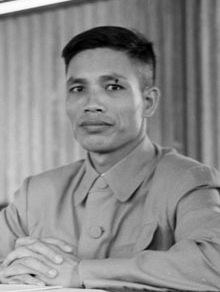Văn Tiến Dũng facts for kids
Quick facts for kids
Văn Tiến Dũng
|
|
|---|---|

Dũng in 1954
|
|
| Secretary of the Central Military–Party Committee of the Communist Party | |
| In office 1984–1986 |
|
| Preceded by | Lê Duẩn |
| Succeeded by | Trường Chinh |
| 6th Minister of Defence | |
| In office February 1980 – February 1987 |
|
| Preceded by | Võ Nguyên Giáp |
| Succeeded by | Lê Đức Anh |
| 2nd Chief of General Staff | |
| In office 1953–1954 |
|
| Preceded by | Hoàng Văn Thái |
| Succeeded by | Hoàng Văn Thái |
| In office 1954–1978 |
|
| Preceded by | Hoàng Văn Thái |
| Succeeded by | Lê Trọng Tấn |
| Member of the Politburo | |
| In office 20 December 1976 – 18 December 1986 |
|
| Personal details | |
| Born | 2 May 1917 Từ Liêm, Vietnam, French Indochina |
| Died | 17 March 2002 (aged 84) Hanoi, Vietnam |
| Political party | |
| Awards | |
| Military service | |
| Allegiance | Vietnam |
| Branch/service | |
| Years of service | 1945–1986 |
| Rank | General |
| Commands | Vietnam People's Army |
| Battles/wars |
|
Văn Tiến Dũng (Vietnamese: [van tǐən zǔŋmˀ]) was a very important Vietnamese general. He was born on May 2, 1917, in a place called Từ Liêm, which is now part of Hanoi. He played a key role in many of Vietnam's major conflicts, including the First Indochina War and the Vietnam War. He was known for his strong leadership and smart military plans.
Contents
Văn Tiến Dũng: A Vietnamese General
Văn Tiến Dũng was a highly respected general in the People's Army of Vietnam (PAVN). He served as the Chief of Staff of the PAVN for many years. Later, he became the commander-in-chief of the army. He also held the position of Vietnam's Minister of Defence.
Early Life and Joining the Fight
Văn Tiến Dũng became a member of the Communist Party of Vietnam in 1936. This was a time when Vietnam was under French rule. He was even put in a French prison, but he managed to escape in 1944. After his escape, he joined the fight against the Japanese forces who occupied Vietnam during World War II.
In August 1945, he led armed groups to take control in several provinces. These included Hòa Bình, Ninh Bình, and Thanh Hóa. This showed his early skills as a military leader.
Key Military Roles
By October 1953, during the First Indochina War, Dũng became the Chief of Staff of the Vietnam People's Army. He worked under the famous General Võ Nguyên Giáp. This was just before the important Siege of Điện Biên Phủ in 1954. For the next two decades, he was considered the second most important military leader in North Vietnam, after General Giáp.
Leading Important Battles
Văn Tiến Dũng played a crucial part in many major military operations.
- Easter Offensive (1972): He commanded the important Tri-Thien-Hue Front during this large attack.
- Vietnam War Commander: In 1974, he took over from General Giáp as the commander-in-chief of the PAVN. This was when the Vietnam War changed from small guerrilla fights to bigger, more traditional battles.
- Spring Offensive (1975): He planned and led the final PAVN attack in 1975. This offensive defeated the South Vietnamese army and led to the capture of Saigon. This event marked the end of the Vietnam War.
Later Career and Retirement
After the Vietnam War, Văn Tiến Dũng continued to lead.
- Cambodian-Vietnamese War: He directed Vietnam's invasion of Khmer Rouge Cambodia. This happened when the Khmer Rouge government was causing problems on the border.
- Sino-Vietnamese War: He also managed the border conflict with People's Republic of China in 1979.
- Minister of Defence: In 1980, he was appointed as the Minister of Defence. He held this position until he retired in December 1986. His retirement happened at the 6th National Congress of the Communist Party of Vietnam.
Văn Tiến Dũng passed away on March 17, 2002, in Hanoi. He was 84 years old. He is remembered as a key figure in Vietnam's military history.
See also
 In Spanish: Văn Tiến Dũng para niños
In Spanish: Văn Tiến Dũng para niños

